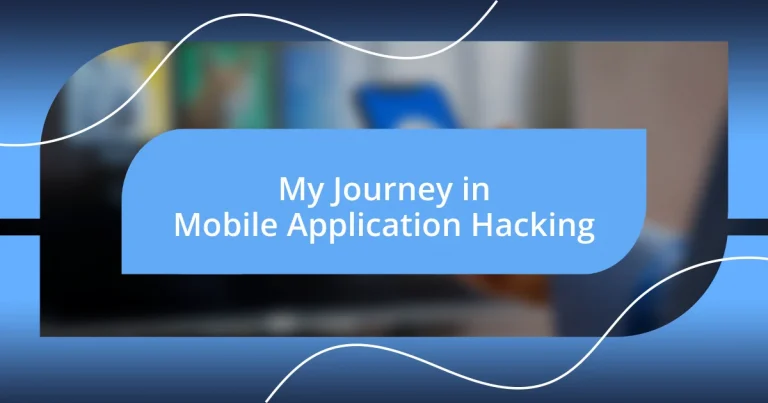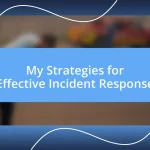Key takeaways:
- Understanding security vulnerabilities in mobile applications is crucial for developers and users to protect sensitive data.
- Utilizing effective tools like Frida and Burp Suite can significantly enhance the process of mobile application hacking and security assessments.
- Legal and ethical considerations are paramount; maintaining integrity and seeking consent are essential in the practice of hacking to avoid negative repercussions.
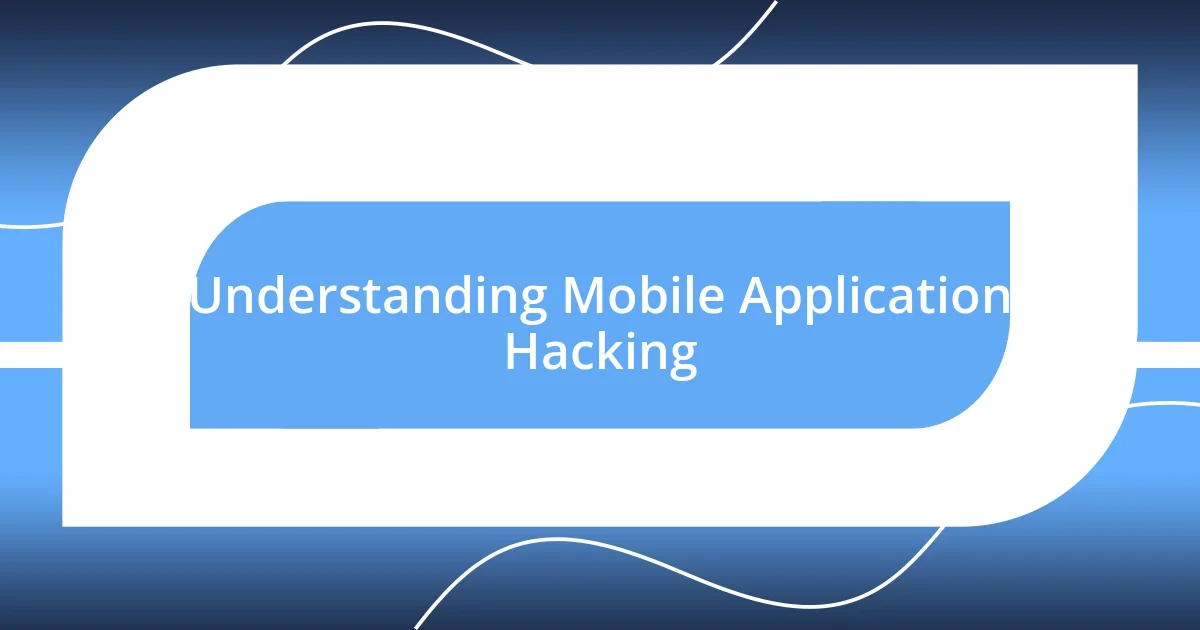
Understanding Mobile Application Hacking
Mobile application hacking involves understanding not just the software but also the security vulnerabilities inherent in mobile platforms. I remember the moment I first encountered a major security flaw in a widely-used app. It made me realize how critical it is to delve deeply into application architecture and protocols because even the smallest oversight can lead to significant breaches.
Have you ever wondered how hackers exploit mobile apps? It often starts with reverse engineering—analyzing an application’s code to uncover weak points. I once spent hours dissecting an app, and the thrill of discovering hidden data led to an eye-opening realization: if I could access this information, so could others with malicious intent.
I believe that understanding mobile application hacking is essential for developers and users alike. The emotional weight of knowing your personal data could be at risk is powerful. It drives home the importance of robust security measures, not just for your applications but for protecting your own digital footprint in an increasingly vulnerable world.
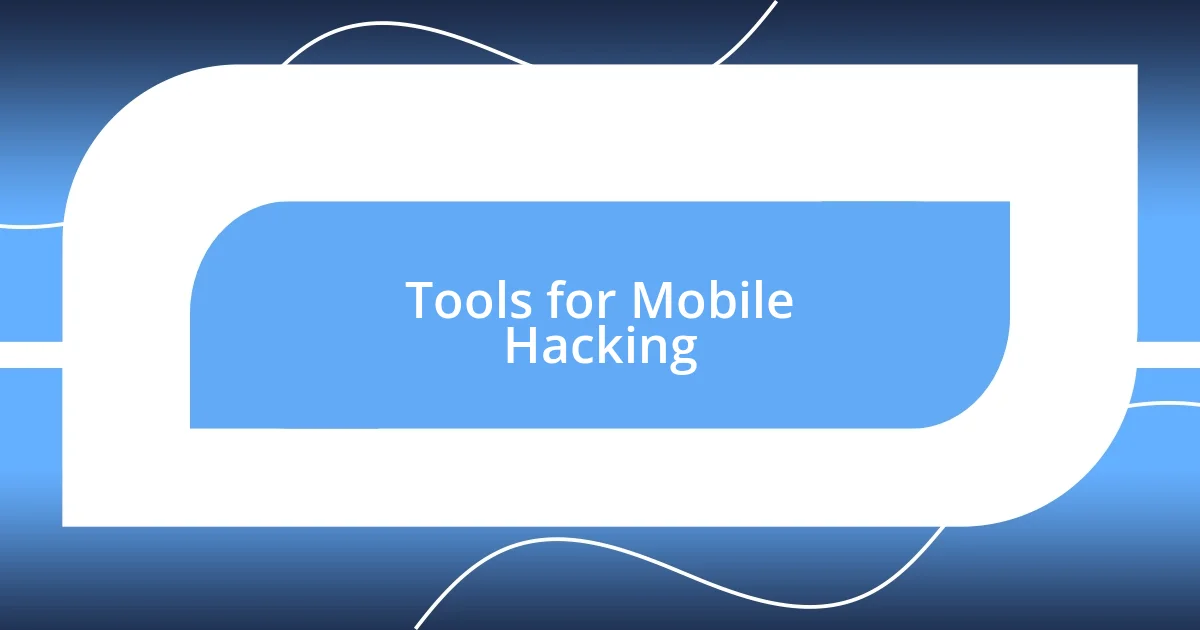
Tools for Mobile Hacking
When it comes to mobile hacking, having the right tools can significantly enhance your capabilities. I remember my first experience trying to exploit a mobile app without the right toolkit—it was frustrating. Since then, I’ve learned the importance of investing in quality software tools that can help dissect applications efficiently.
Here are some tools that I find invaluable for mobile application hacking:
- Frida: A dynamic instrumentation toolkit that offers powerful features for reverse engineering.
- Burp Suite: An essential proxy tool that allows you to intercept and modify HTTP/S traffic easily.
- Drozer: A versatile tool for testing the security of Android apps, providing a suite of various helpful utilities.
- APKTool: I found this particularly useful for decoding Android application packages to analyze their underlying structure.
- MobSF (Mobile Security Framework): An open-source tool that automates the security assessment of mobile apps, which has saved me countless hours.
Each tool serves a unique purpose, but together they form a robust arsenal for any mobile hacker looking to explore, diagnose, or secure mobile applications.
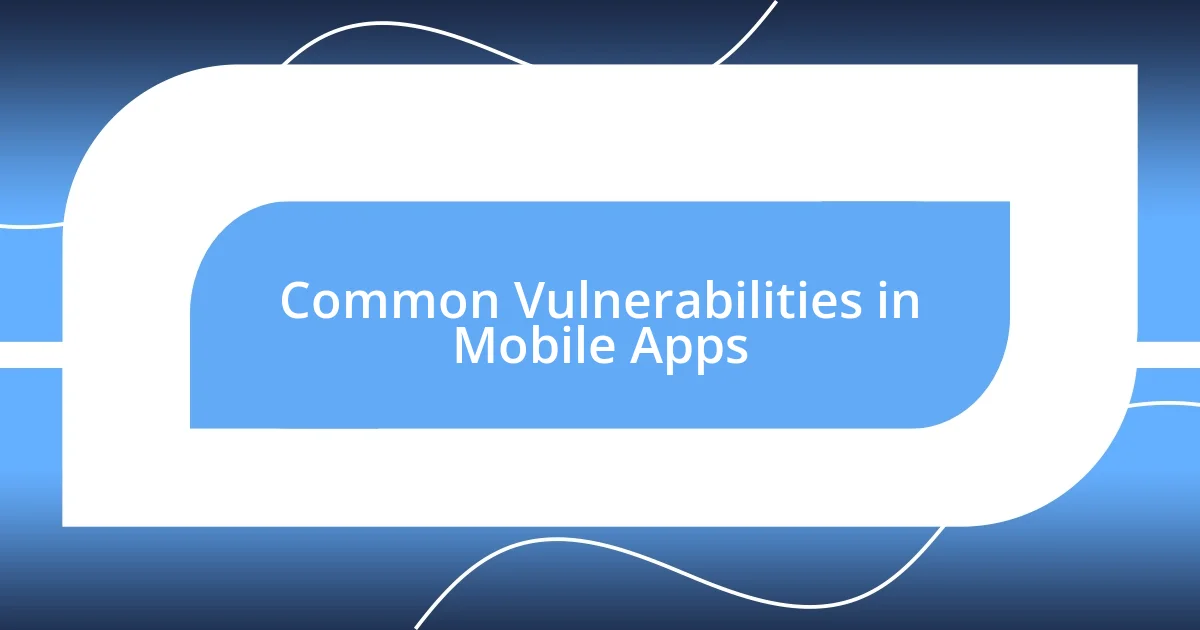
Common Vulnerabilities in Mobile Apps
Common vulnerabilities in mobile applications can offer a treasure trove of insights for those in the cybersecurity realm. From my experiences, I’ve seen that insecure data storage is prevalent; many apps store sensitive information without adequate encryption. One time, I stumbled across an app that saved user credentials in plain text. It served as a stark reminder of how crucial it is to secure data both in transit and at rest—a lesson I won’t forget.
Another vulnerability I’ve encountered often is inadequate authentication mechanisms. I remember testing an app that allowed multiple attempts to guess a user’s password without any lockout feature. This oversight could have easily opened the door for unauthorized access. It speaks volumes about the importance of implementing strong password policies, two-factor authentication, and intrusion detection systems to anticipate potential threats.
Finally, the lack of secure communication channels is another critical vulnerability I’ve found. Many mobile apps fail to implement SSL/TLS correctly, leaving data vulnerable during transmission. During one of my assessments, I noticed an app transmitting sensitive user data over HTTP instead of HTTPS. Discovering vulnerabilities like these fuels my passion for mobile application security—it shows just how vital awareness and proactive measures are in protecting user data from malicious actors.
| Vulnerability | Description |
|---|---|
| Insecure Data Storage | Storing sensitive information without proper encryption. |
| Weak Authentication | Inadequate measures like allowing unlimited login attempts. |
| Insecure Communication | Failure to use secure channels like TLS for data transmission. |

Steps for Securing Mobile Applications
When securing mobile applications, the first step I recommend is to prioritize encryption. I recall a project where I was tasked with revising an app’s data storage. The original app kept sensitive user information unencrypted, and the repercussions were almost disastrous. Implementing strong encryption not only protects user data but also establishes trust. Imagine using an application knowing your personal information is shielded—wouldn’t you feel more secure?
Next on my list is reviewing authentication processes. I’ve seen firsthand the implications of weak or flawed authentication schemes. There was this time I analyzed an app that relied solely on passwords without implementing multi-factor authentication. It made me wonder, how much control do we really have over our accounts if they’re so easily accessible? Strengthening authentication methods can significantly reduce the risk of unauthorized access and give users more confidence in their security.
Lastly, ensuring secure communication through protocols like SSL/TLS is essential. I once encountered an app that exchanged data without any encryption, leaving it exposed during transmission. It was concerning to think about how easily someone could intercept sensitive information. My experience taught me that securing communication channels isn’t just a technical requirement; it’s about safeguarding users’ trust. What good is an app if users don’t feel safe using it?
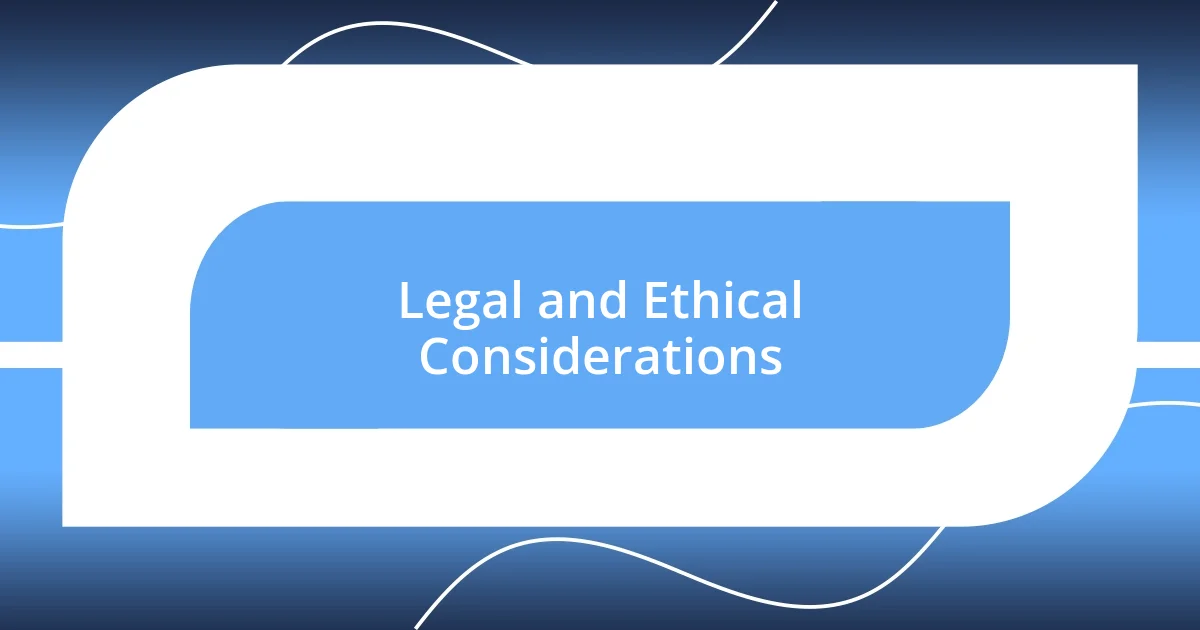
Legal and Ethical Considerations
Navigating the world of mobile application hacking introduces a myriad of legal and ethical considerations that cannot be overlooked. From my experience, maintaining ethical integrity isn’t just a guideline; it’s a fundamental principle that governs how we interact with technology. For instance, during my early days, I once stumbled upon a vulnerability that could expose user data. While the adrenaline rush of identifying that flaw was exhilarating, I quickly realized the implications of exploiting it without consent. It made me wonder—how would I feel if someone did the same to me?
Additionally, the legality of hacking often rides on the context and intent behind the action. I recall working with a team on a penetration test where we had explicit permission from the client. That moment highlighted for me the importance of transparency and consent. It’s vital to ask oneself, “Am I helping or harming?” The fine line between ethical hacking and malicious actions can often come down to that simple yet profound question.
Moreover, the consequences of unethical behavior can extend beyond personal repercussions. I learned this lesson when witnessing a colleague’s careless actions lead to legal troubles for their organization. A seemingly harmless exploration of vulnerabilities can escalate into a costly litigation nightmare. This experience reinforced my belief that ethical guidelines aren’t just about safeguarding one’s reputation—they’re essential for the greater good in the tech community. After all, is there any greater commitment than ensuring the safety of our digital spaces?
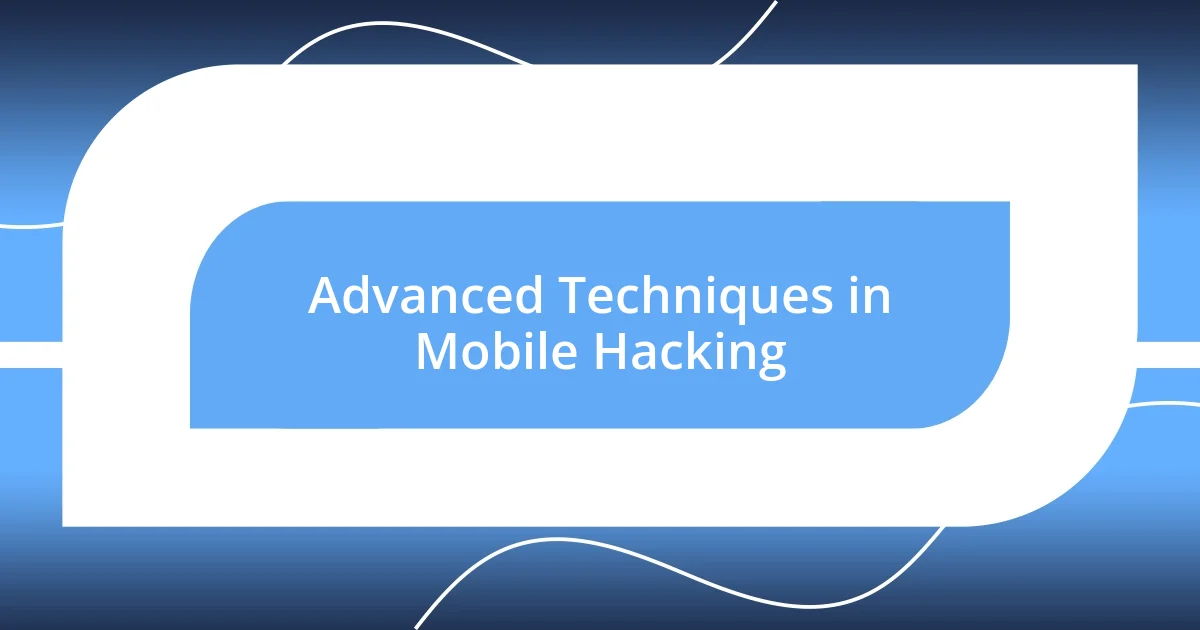
Advanced Techniques in Mobile Hacking
When exploring advanced techniques in mobile hacking, one emerging method that has caught my attention is reverse engineering. I remember diving deep into an app’s code once, attempting to uncover its vulnerabilities. The thrill of peeling back layers of complexity felt almost like unwrapping a gift, each line revealing potential weaknesses. I often ponder, how many hackers are out there right now using the same techniques to exploit unsuspecting users?
Another fascinating approach I encountered is the use of man-in-the-middle (MitM) attacks. During a security workshop, we simulated an attack that intercepts communications between a mobile device and a server. It was eye-opening to see just how easily information could be captured without the end-user realizing it. This experience made me reflect on the importance of educating users about secure networks. After all, wouldn’t you want to know when your data is vulnerable?
Lastly, I can’t overlook the growing significance of automated tools in mobile application hacking. While I’ve always valued hands-on techniques, I was astonished by how much time these tools saved during assessments. I recall a particular instance where a tool highlighted vulnerabilities in seconds that would have taken hours to discover manually. It raises an interesting question: do we embrace technology to enhance our skills, or do we risk becoming overly reliant on it?

Resources for Continuous Learning
As I embarked on my journey in mobile application hacking, I found numerous resources that continually fueled my growth. Online platforms like OWASP, which provides a treasure trove of knowledge on application security, became my go-to for understanding vulnerabilities. I recall spending countless nights scouring through their materials, immersing myself in case studies that mirrored real-life situations. It was fascinating to see theory come alive, and it really made me question: how could I apply these lessons to future projects?
In addition to the wealth of online resources, I’ve discovered that participating in Capture The Flag (CTF) competitions can be both exhilarating and educational. I distinctly remember my first CTF event; the thrill of racing against the clock to solve challenges not only sharpened my skills but also connected me with a vibrant community of peers. Engaging with others in this setting opened my eyes to different approaches and ideas, prompting me to ask, “What can I learn from my fellow hackers that can elevate my own understanding?”
Moreover, I strongly advocate for seeking mentorship in this field. Collaborating with seasoned professionals can be a game-changer. There was a pivotal moment when I reached out to a respected senior in the industry, who graciously shared insights from their own experiences—priceless gems I would have otherwise missed. It reinforced my belief that sometimes the best resources aren’t just books or blogs, but the people who’ve walked the path before us. Reflecting on this, I often ask myself: how can I contribute to the growth of others just as I have benefited from the experiences of those ahead of me?












